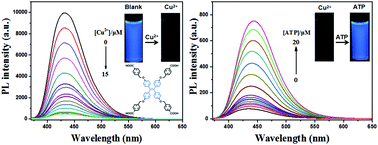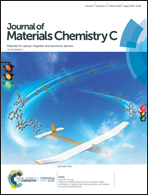Turn-off/on fluorescent sensors for Cu2+ and ATP in aqueous solution based on a tetraphenylethylene derivative†
Abstract
Two novel fluorescent sensors based on a tetraphenylethylene derivative (TPE-COOH) were designed and prepared for the rapid detection of cupric ion and adenosine triphosphate (ATP) in 100% aqueous solution. The properties of the sensors were elucidated by UV-vis absorption spectra, photoluminescence spectra, scanning electron microscopy and dynamic light scattering experiments. The results reveal that the TPE-COOH suspension had specific selectivity for cupric ion due to the disassembly of the TPE-COOH aggregates. Moreover, the introduction of ATP into the TPE-COOH/Cu2+ solution led to the re-assembly of TPE-COOH on account of the competitive binding of ATP with Cu2+. Accordingly, the sensitive, selective and fast recognition of ATP can be realized by a “turn-on” fluorescent response. In addition, the TPE-COOH compound can also enable the fabrication of test strips, which provide a low cost, simple and flexible way to detect trace amounts of Cu2+ and ATP in aqueous solutions or organisms.



 Please wait while we load your content...
Please wait while we load your content...